Football-Specific Speed Drills
by Developing Speed
Kinetic Select
May 2017
This article presents two football-specific speed drills in detail—the single-leg box explosion and the mountain climber.
The following is an exclusive excerpt from the book Developing Speed, part of the NSCA’s Sport Performance Series with Human Kinetics. All text and images provided by Human Kinetics.
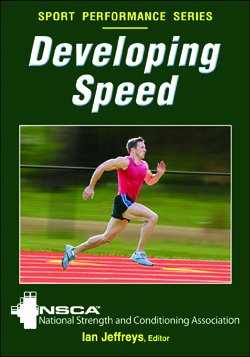
Football
Football is a diverse sport played by a variety of athletes, whose ideal physical stature is largely dictated by the requirements of each playing position. However, one common thread provides an advantage for all football players at any position: to be faster than the opponent. It has been said that in football strength punishes, but speed kills. Speed training for football can be as complex or as simple as the coaching staff chooses to make it. It is not necessary to go out and spend a lot of money on specific equipment. Even though the requirements for playing speed depend on position, every athlete on the field can benefit from training to become faster.
Single-Leg Box Explosion
Aim: To develop linear first-step speed and acceleration.
Action: The athlete places one foot on a 6- to 15-inch (15-38 cm) box (or stadium step or bleacher) while remaining in a hip-width stance. The shin of the leg on the box is parallel to the torso and supporting leg. The arms are in a loose, 90-degree position, with the arm opposite the leg on the box in a forward blocked position (Figure 1.1). Assuming a position to the side of the box lets the athlete retain a forward lean while keeping the feet hip-width apart and allows the athlete to drive off of the box without fear of landing on the box. With the foot on the box, the athlete pushes off and forcefully drives the opposite knee upward, maintaining dorsiflexion (toes toward shin) at the ankle and driving the body as high as possible. During the movement, the athlete drives the arms into opposite positions, maintaining the loose 90-degree angle at the elbows. The majority of arm movement occurs at the shoulder joints (Figure 1.2). The athlete should be able to perform the movement without bending at the waist or allowing the back to hunch over.
Coaching Points
• The back is flat and the eyes are on the horizon
• The knee drives and the hips do not move backward
• Remind athletes to move as explosively as possible from a stationary position without performing a countermovement
Variation
The athlete begins with a low box to develop coordination during the exercise, then increases the height to build strength though a greater range of motion. This movement more closely resembles the height of the knee drive while running. Additionally, the athlete progresses from single-response sets to multiple or continuous response sets. To add specificity, the athlete can react to visual or auditory commands.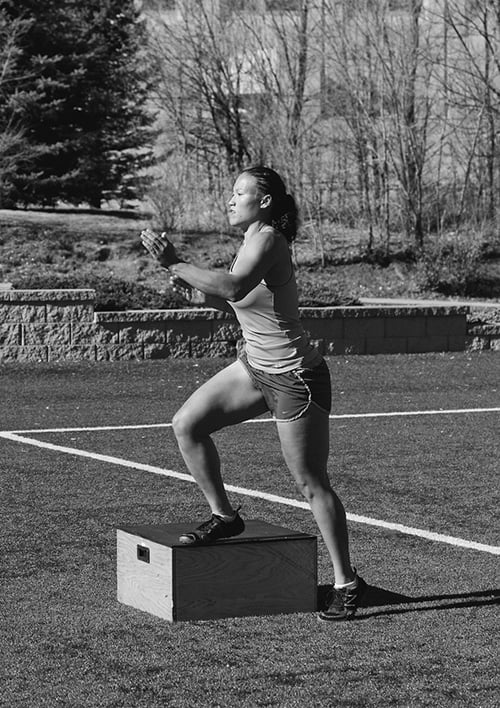
Figure 1.1 Single-Leg Explosion
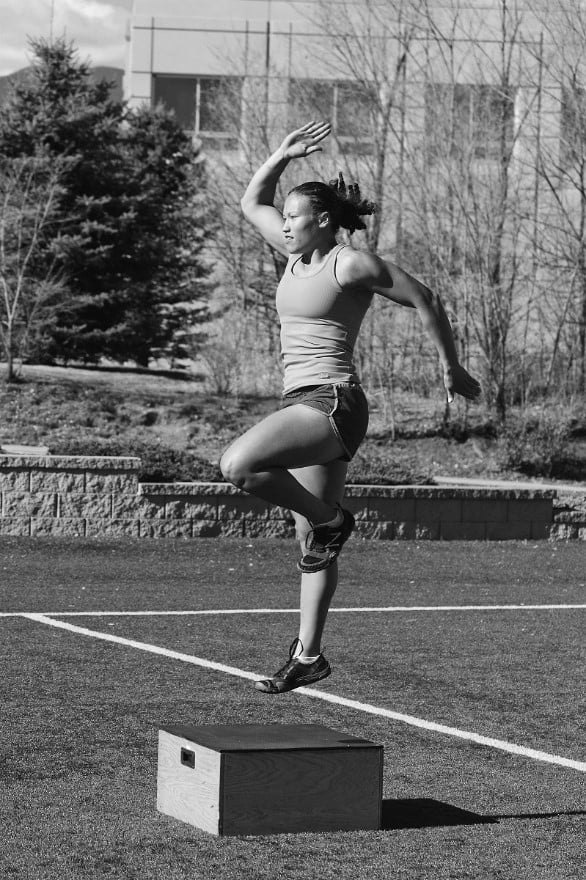
Figure 1.2 Single-Leg Explosion
Mountain Climber
Aim: To develop acceleration technique.
Action: The athlete assumes a push-up position with hands and toes on the ground and the arms extended, the back flat, and the knees and hips extended. Then the athlete flexes one leg at the knee and hip and positions that foot on the ground under the hips. The hips do not rise away from the ground. This is the start position. On the coach’s command, the athlete drives the lead leg back to a fully extended position and moves the extended leg forward to the bent-knee and bent-hip position (Figures 2.1 and 2.2). The hips should not bounce or rise during this movement.
Coaching Points
• The back is flat, head neutral, and hips and knees fully extended
• Remind athletes to focus on extending the drive leg directly to the fully extended trail-leg position
• Athletes switch both legs at the same time and keep the drive knee between the arms
Variation
To simplify the movement, the athlete can first learn the positions through this sequence: right knee forward, both legs straight, and left knee forward. The athlete holds each position for 15 seconds. The athlete can then march while holding the correct body positions. At this point, the athlete is ready for the single-response version already described. This drill can move forward to a double response (switch and return), a triple response (switch, return, and switch) and finally a rapid fire for a set time, usually about 5 seconds.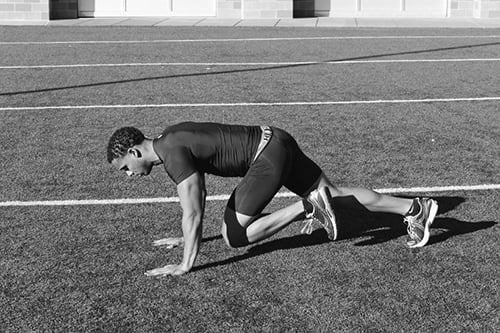
Figure 2.1 Mountain Climber - Left
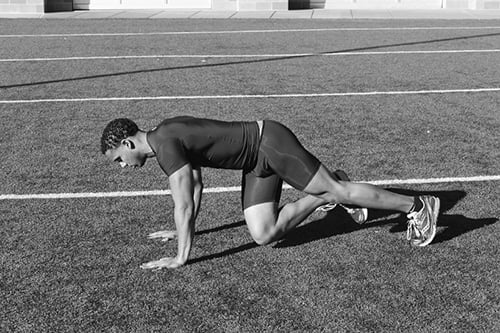
Figure 2.2 Mountain Climber - Right
Developing Speed features several other football-specific speed drills, along with drills focused on baseball, basketball, ice hockey, rugby, soccer, tennis, and track. The book is available in bookstores everywhere, as well as online at NSCA.com.
- Privacy Policy
- Your Privacy Choices
- Terms of Use
- Retraction and Correction Policy
- © 2025 National Strength and Conditioning Association